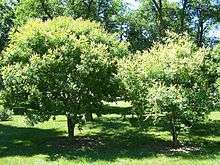Maackia amurensis
| Maackia amurensis | |
|---|---|
 | |
| Maackia amurensis at Morton Arboretum | |
| Scientific classification | |
| Kingdom: | Plantae |
| (unranked): | Angiosperms |
| (unranked): | Eudicots |
| (unranked): | Rosids |
| Order: | Fabales |
| Family: | Fabaceae |
| Subfamily: | Faboideae |
| Tribe: | Sophoreae |
| Genus: | Maackia |
| Species: | M. amurensis |
| Binomial name | |
| Maackia amurensis Rupr. | |
Maackia amurensis, commonly known as the Amur maackia, is a species of tree in the Fabaceae family that can grow 15 metres (49 ft) tall. The species epithet and common names are from the Amur River region, where the tree originated; it occurs in northeastern China, Korea, and Russia.[1]
Only reaching about 15 feet (4.6 m) tall in the American midwest, Amur maackia tolerates severe dryness, cold and heavy soils. More interesting than the summer flowers are the unfolding buds in spring which appear silvery and showy like flowers with frost on them.
Named for Karlovich Maack (Richard Maack), a 19th-century Siberian explorer who discovered the tree in the Amur River region on the Siberian Chinese border.
The isoflavones daidzein, retusin, genistein and formononetin and the pterocarpans maackiain and medicarpin can be found in M. amurensis cell cultures.[2]
References
- ↑ Bojian Bao & Michael A. Vincent. "Maackia amurensis". Flora of China. Missouri Botanical Garden, St. Louis, MO & Harvard University Herbaria, Cambridge, MA. Retrieved 30 April 2012.
- ↑ Isoflavonoid production by callus cultures of Maackia amurensis. S.A Fedoreyev, T.V Pokushalov, M.V Veselova, L.I Glebko, N.I Kulesh, T.I Muzarok, L.D Seletskaya, V.P Bulgakov and Yu.N Zhuravlev, Fitoterapia, 1 August 2000, Volume 71, Issue 4, Pages 365–372, doi:10.1016/S0367-326X(00)00129-5
External links
- Maackia amurensis Diagnostic photographs and information, Morton Arboretum acc. 147-71-5